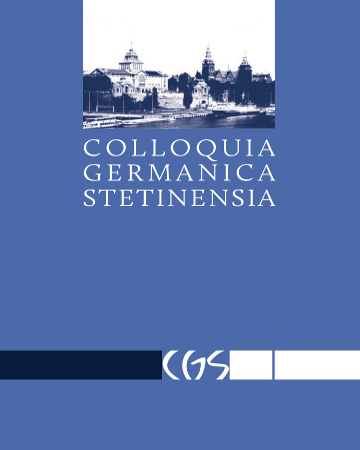







| Authors: |
Barbara
Komenda-Earle

Uniwersytet Szczeciński, Instytut Językoznawstwa |
| Keywords: | Simple Forms mythological idioms liveness of idioms variants corpus research |
| Data publikacji całości: | 2023-11 |
| Page range: | 20 (181-200) |
| Downloads ?: | 163 |
| 1. | Bausinger, Hermann. Formen der „Volkspoesie“. Berlin: Erich Schmidt, Berlin 1968 (2., verbesserte u. vermehrte Aufl. ebd. 1980) (=Grundlagen der Germanistik 6). |
| 2. | Burger, Harald. „Problembereiche einer historischen Phraseologie“. In: Europäische Phraseologie im Vergleich: gemeinsames Erbe und kulturelle Vielfalt. EUROPHRAS 95, hrsg. v. Wolfgang Eismann, 79–108. Bochum: Brockmeyer, 1998 (= Studien zur Phraseologie und Parömiologie 15). |
| 3. | Dobrovol’skij, Dmitrij, Elisabeth Piirainen. „Sprachliche Unikalia im Deutschen: Zum Phänomen idiomatisch gebundener Formative“. Folia Linguistica. Acta Societatis Linguiticae Europaeae XXVIII (1994): 449–473. |
| 4. | Dobrovol’skij, Dmitrij. Kognitive Aspekte der Idiom-Semantik: Studien zum Thesaurus deutscher Idiome. Tübingen: Narr, 1995. |
| 5. | Dobrovol’skij, Dmitrij. Phraseologie als Objekt der Universalienlinguistik. Leipzig: VEB Verlag Enzyklopädie, 1988. |
| 6. | Fleischer, Michael. Die Semiotik des Spruches: kulturelle Dimensionen moderner Sprüche (an deutschem und polnischem Material). Bochum: Brockmeyer, 1991. |
| 7. | Häcki Buhofer, Annelies. „Psycholinguistische Aspekte der Bildhaftigkeit von Phraseologismen“. In: EUROPHRAS 88. Phraséologie Contrastive. Actes du Colloque International Klingenthal – Strasbourg. Strasbourg 12–16 mai 1988, hrsg. v. Gertrud Gréciano, 165–175. Strasbourg: Université des sciences humaines, Département d’études allemandes 1989. (Collection Recherches Germaniques 2). |
| 8. | Jolles, André. Einfache Formen. Legende, Sage, Mythe, Rätsel, Spruch, Kasus, Memorabile, Märchen, Witz. Tübingen: Niemeyer, 1930/82006. |
| 9. | Koch, Walter (Hg.). Simple Forms: An Encyclopaedia of Simple Text-types in Lore and Literature. Bochum: Brockmeyer, 1994. |
| 10. | Mieder, Wolfgang. „Neues von Sisyphus“. Sprichwörtliche Mythen der Antike in moderner Literatur, Medien und Karikaturen. Wien: Praesens, 2013. |
| 11. | Munske, Horst Haider. „Wie entstehen Phraseologismen?“ In: Vielfalt des Deutschen. Festschrift für Werner Besch, hrsg. v. Klaus J. Mattheier, Klaus-Peter Wegera, Walter Hoffmann, Jürgen Macha, Hans-Joachim Solms, 481–516. Frankfurt a. M., Berlin u.a.: Peter Lang 1993. |
| 12. | Permjakov, Grigorij L.: Od pogovorki do skazki (zametki po obščej teorii kliše). Moskva: Nauka, 1970. |
| 13. | Piirainen, Elisabeth. Widespread Idioms in Europe and Beyond. Toward a Lexicon of Common Figurative Units. New York, Washington u. a.: Peter Lang, 2012. |
| 14. | Röhrich, Lutz, Wolfgang Mieder. Sprichwort. Stuttgart: Metzler, 1977. |
| 15. | Soehn, Jan-Philipp. Über Bärendienste und erstaunte Bauklötze. Idiome ohne freie Lesart in der HPSG. Frankfurt a. M., Berlin u. a.: Peter Lang, 2006. |
| 16. | Zifonun, Gisela, Gerhard Strauß. „Achillesferse und Ariadnefaden. Antike Bilder in deutschen Texten“. In: Von Intentionalität zur Bedeutung konventionalisierter Zeichen. Festschrift für Gisela Harras zum 65. Geburtstag, hrsg. v. Kristel Proost, Edeltraut Winkler, 103–123. Tübingen: Narr, 2006. (= Studien zur Deutschen Sprache 35) |